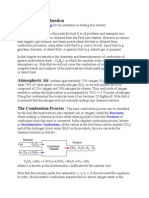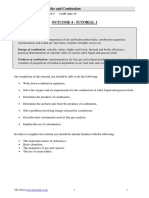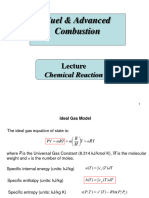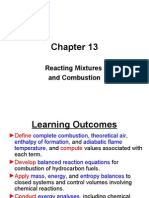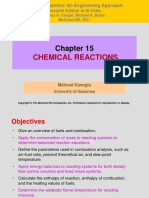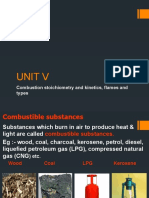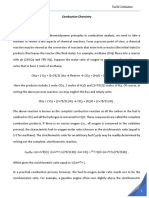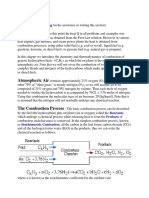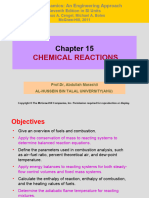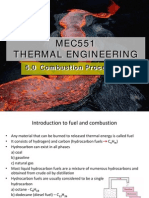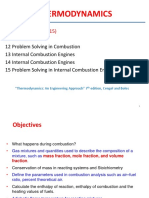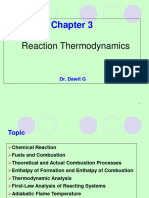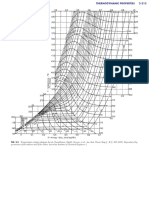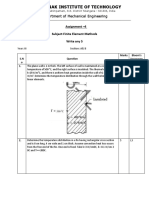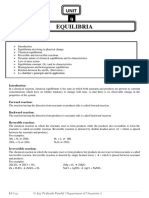SCHOOL OF CHEMICAL & BIOMEDICAL ENGINEERING
CHEMICAL & BIOMOLECULAR ENGINEERING
CHEMICAL/ BIOMOLECULAR ENGINEERING LABORATORY 2
Year 1: Material/ Energy Balance for a
Combustion
Process at Steady State
Name: Muhammad Ilyas Hassan
Matriculation Number: U1322800G
Group: 6
Date of Experiment: 24
th
Feb 2014
1. Aim
The objective of the experiment is to derive the material and
energy balance formula for a steady-state combustion process by
calculating the air excess ratio, stoichiometry, higher heating
value, lower heating value, etc and thus, understand the concept
of a steady state combustion process and the technique of Gas
Chromatography.
2. Abstract
The traditional combustion process is heavily used today for to
drive many purposes and processes mainly due to its energy
output. In this combustion process, a substance with high bond
energy typically hydrocarbons, are used to be burnt excess air,
due to its oxygen content, to produce a great deal of energy.
Typical end products for combustion is carbon dioxide and water,
sometimes carbon monoxide, depending on weather the supply of
oxygen is limited or not. There are many methods to determine
the air content to monitor the combustion process and one way is
the use of Gas Chromatography. In this study, we explore the basic
principles unlying the combustion process by combusting
propane, C3H8 with excess air and monitoring its mass and energy
balance using selected methods of calculation from experimental
values and not to mention, Gas Chromatography to give us a
clearer idea of combustion as a whole.
3. Principles
3.1 Stoichiometry Equation and Conditions
Just like any other chemical process/experiment, we have to
understand the theoretical or stoichiometrical equation of the
combustion process, which not only shows the chemical
compositions of the reactants and products, but also the
theoretical or ideal mole ratios.
The conditions at which the reactions take place also matter, as it
affects the compositions and enthalpies of the chemical
substances. In this experiment, the combustion takes place at
atmospheric pressure of 1 atm and room temperature of 24.4
o
C.
Under the atmospheric pressure, a fuel (propane gas) reacts with
O2 (Air, O2: N2 = 1 :3.76 ) and this process is exothermic and the
stoichiometric combustion formula is:
C
3
H
8
+5(O
2
+3.76N
2
) 3CO
2
+4H
2
O+18.8N
2
+ H where H is enthalphy
of combustion
As the Air/fuel ratio changes, the enthalpy of combustion and the
composition of the product (exhaust gases) will change
accordingly. However, the principles of energy and materials
balance are always valid and can be used to solve the unknowns.
3.2 Mass Balance and Terminologies
Mass balance is the calculation of the different amount of
reactants and/or products based on given values and the
stoichiometric equation above. It gives us specific figures on the
amounts of input and output to the system, which in this case is
the Fireboy burner, the combustion chamber where the
process takes place.
Theoretical & Excess Air: Theoretical air is the quantity of air
that contains theoretical oxygen (5 moles in the above example)
Percent excess air:
(moles air)
fed
(moles air)
theo
100%
(moles air)
theo
Dry and Wet basis: composition on a wet basis denotes the
component mole fractions of a gas that contains water;
composition on a dry basis signifies the component mole fraction
of the same gas without water.
3.3 Energy Balance
Similar to mass, the energy balance helps us find the energy
output of the combustion process. Energy balance is based on 1
st
Law of Thermodynamics, law of the conservation of energy.
First laws for open system at steady state: Our system is the
open system at steady state, the first
laws can be written as:
Fig 1: First laws for open system at steady state
Where,
Fig 2: Heat component of the equation on the open system at steady state
Standard heat (enthalpy) of combustion, H
c
0
: the heat of
reaction of the substance with oxygen to yield specific products
(e.g., CO
2
, H
2
O), with both reactants and products are at the
reference
temperature and pressure (25C, 1 atm).
Standard heat (enthalpy) of formation, H
0
f
: enthalpy change
associated with the formation of 1 mole compound from naturally
occurring elements under reference state (25C, 1 atm ).
The heat of combustion is related to heat of formation:
H
0
=
H
0
H
0
Enthalpy changes for processes involving chemical reaction:
Two methods exists for the calculation of the overall enthalpies
changes, they are: (1) heat of reaction method (molecular species
at 25C, 1atm), and (2) heat of formation method (naturally
occurring elemental species at 25C, 1atm). In this experiment,
the former method is used.
3.4 Gas Chromatography
Gas Chromatography (GC) is a technique used to separate
substances that are volatile. It makes use of an inert carrier gas to
separate the compounds due to their differences in partitioning
behavior between the mobile gas phase and the stationary phase
in the column. Simply said, this technique helps in the analysis of
the exhaust gas for the combustion process. More about GC in the
Appendix A.
4. Equipment and Materials
The experiment is fairly a straight-forward one with 3 main
parts; combustion, sampling and analysis.
Combustion chamber
Fireboy burners equipped with quartz tube are used as the
combustion device (chambers), propane gas as the fuel.
A MKS Mass gas flow controller is used to regulate the volumetric
flow rate of the fuel gas. Shimadzu GC 14B is used to analyze the
composition of the exhaust gases (Appendix I).
Air sampling
A micro-syringe is used as the sampling device.
Analysis
Gas Chromatogram
Other equipments include common lab apparatus including the
traditional thermometer.
5. Procedure
The experiment is fairly a straight-forward one with 3 main
parts; combustion, sampling and analysis. A brief outline of the
procedure is listed below.
1. The GC was started first to ensure that the base-line was
stable before using later in the experiment.
2. Gas fuel supply was turned on, in which at the same time
the mass flow controller (MFC) was switched on and checked
zero.
3. Propane flow rate was set, and the process was ignited.
4. Waiting time of 3 minutes to ensure that the process has
gone to steady
state.
5. Sample of the exhaust gas was taken using the micro-
syringe and the
temperature was recorded.
6. Sample gas was injected into the analytical port of the GC
before starting the analysis.
7. Computation and calculation of results
6. Results and Calculations
6.1 GC Analysis
The Gas Chromatography (GC) technique was used to analyse
and determine the content composition of the air mixture sample
drawn from the outlet of the Fireboy burner, that was taken
using the micro-syringe.
Table 1 below is taken straight from the GC.
GC Results Mole fraction (dry basis)
CO2 0.1030
N2 0.8290
02 0.0680
Total (dry basis) 1.0000
H20 0.1373
Total (wet basis) 1.1373
Table 1: GC analysis results (dry basis)
Table 2 is derived from table one, taking into account the water
vapour content of the gas.
Wet basis Mole fraction (wet basis)
CO2 0.09056272
N2 0.728898007
O2 0.05978898
H20 0.120750293
Total (wet basis) 1.000
Table 2: GC Analysis Results (wet basis)
6.2 Results
Using the above data from the GC, the mass and energy balances
and the input molar flow rate of the propane gas, the respective
values for the different components of input and output were able
to be determined using calculations.
Below are the tabulated results from the calculations:
D
a
t
a
c
a
l
c
u
Table 3: Tabulation of all calculations and results
6.3 Calculations and Derivations
Below are the workings showing the derivation of the values
tabulated above. These values are calculated in sequential order
and makes use of relevant assumptions and mass and energy
balances. Below is a simplified diagram of the system.
Inlet Outlet GC analysis
Y
i
n
i
^
H
i
y
i
n
i
^
H
i
1
% mol/s kJ/mol % mol/s kJ/mol
mol frac
N
2
76.50
6.665 x
10
-3
0 72.90
6.665 x
10
-3
11.080 0.728898007
O
2
20.33
1.772 x
10
-3
0 5.98
5.467 x
10
-4
12.061 0.05978898
C
3
H
8
3.17
2.76042
x 10
-4
0 nil nil nil 0
H
2
O
nil nil nil 12.08
1.104 x
10
-3
13.132 0.120750293
CO
2
Nil nil nil 9.06
8.281 x
10
-4
16.967 0.09056272
CO
nil nil nil nil nil nil 0
Fig 3: Simple diagram of the open system
6.3.1 Flow Rate of Propane Gas (Inlet)
Visual Flow Rate of C3H8 = 371 cm
3
/ min
1 mol of (any) gas has a net volume of 24dm
3
= 24000cm
3
at R.T.P
Flow Rate of C3H8 = 371 cm
3
/ min x 1mol/ 24000cm
3
x 1min/ 60s
= 2.76042 x 10
-4
mol/s
6.3.2 Flow Rate of Carbon Dioxide (Outlet)
Stoichiometric Equation:
C3H8 + 5(O2 + 3.76N2) 3CO2 + 4H2O + 18.8N2 + H
For this equation to be valid, it was assumed that complete
combustion occurred and was justified with the absence of a
Carbon Monoxide product of incomplete combustion.
Flow Rate of CO2 = 3 x 2.76042 x 10
-4
mol/s = 8.281 x 10
-4
mol/s
Q
T
in
=
25C
T
out
=
401C
n
prop
n
oxy
n
n
prop
n
oxy
n
nitro
n
CO
2
n
CO
n
water
6.3.3 Flow Rate of Water (Outlet)
Stoichiometric Equation:
C3H8 + 5(O2 + 3.76N2) 3CO2 + 4H2O + 18.8N2 + H
For this equation to be valid, it was assumed that complete
combustion occurred and was justified with the absence of a
Carbon Monoxide product of incomplete combustion.
Flow Rate of H2O = 4 x 2.76042 x 10
-4
mol/s = 1.104 x 10
-3
mol/s
6.3.4 Flow Rate of Nitrogen (Outlet)
Stoichiometric Equation:
C3H8 + 5(O2 + 3.76N2) 3CO2 + 4H2O + 18.8N2 + H
The flow rate of Nitrogen and Oxygen cannot be obtained using
the stoichiometric ratio with the basis of Propane gas (i.e 18.8 x
2.5347 x 10
-4
mol/s). This is based on the chromatogram
obtained, there are no peaks indicative of Carbon Monoxide. This
implies that complete combustion has occurred yielding the
Carbon Dioxide and Water. However, we can assume that since
Propane gas has undergone complete combustion, the limiting
reactant is thus Propane. This can inevitably mean that the air
was supplied in excess to ensure that complete combustion
occurs. Thus the stoichiometric values and coefficient will not
give a fair and reliable representation of answer due to the fuel
air ratio. It is only recommended that we check with the
chromatogram and use the comparison method for the answers.
Based on GC, the mol frac of CO2 = 0.09056272
0.09056272 = 8.281 x 10
-4
mol/s
Based on GC, the mol fraction of N2 = 0.728898007
Flow Rate of N2 = [(8.281 x 10
-4
mol/s)/ 0.09056272] x
0.728898007
Flow Rate of N2 = 6.665 x 10
-3
mol/s
6.3.5 Flow Rate of Oxygen (Outlet)
Stoichiometric Equation:
C3H8 + 5(O2 + 3.76N2) 3CO2 + 4H2O + 18.8N2 + H
Based on GC, the mol frac of CO2 = 0.09056272
0.09056272 = 8.281 x 10
-4
mol/s
Based on GC, the mol fraction of O2 = 0.05978898
Flow Rate of O2 = [(8.281 x 10
-4
mol/s)/ 0.09056272] x
0.05978898
Flow Rate of O2 = 5.467 x 10
-4
mol/s
6.3.6 Flow Rate of Nitrogen (Inlet)
Stoichiometric Equation:
C3H8 + 5(O2 + 3.76N2) 3CO2 + 4H2O + 18.8N2 + H
Flow Rate of N2 (Inlet) = Flow Rate of N2 (Outlet) = 6.665 x 10
-3
mol/s
This is due to the nature of inertness of Nitrogen Gas.
The inlet flow rate of Nitrogen is the same to that of the outlet
flow rate of Nitrogen due to its inertness and its presence in the
chromatogram despite the fact that complete combustion will not
yield any Nitrogen products. The presence of Nitrogen is due to
its role as a constituent in air and is part of the air fuel ratio.
This is because, for every 1 mole of Oxygen, there is 3.76 moles of
Nitrogen. Thus the chromatogram which displays the peak for
Nitrogen simply implies that this Nitrogen gas constituent is non
reactive as it does not contribute to the combustion but it is
present due to its function as a component of air. Hence, the
number of moles of inlet Nitrogen gas is the same as the outlet.
6.3.7 Flow Rate of Oxygen (Inlet)
Stoichiometric Equation:
C3H8 + 5(O2 + 3.76N2) 3CO2 + 4H2O + 18.8N2 + H
For every 1 mole of Oxygen, there is 3.76 moles of Nitrogen
Flow Rate of N2 (Inlet) = 6.665 x 10
-3
mol/s
Flow Rate of O2 (Inlet) = (6.665 x 10
-3
mol/s)/ 3.76 = 1.772 x 10
-3
mol/s
6.3.8 Inlet Molar Flow Rate and Mole Fraction
Inlet Molar Flow Rate = n total (C3H8 + O2 + N2)
Inlet Molar Flow Rate = 6.665 x 10
-3
mol/s + 1.772 x 10
-3
mol/s +
2.76042 x 10
-4
mol/s
Inlet Molar Flow Rate = 8.713 x 10
-3
mol/s
Mole Fraction of C3H8 = (2.76042 x 10
-4
mol/s)/ (8.713 x 10
-3
mol/s) = 0.0317
Mole Fraction of O2 = (1.772 x 10
-3
mol/s)/ (8.713 x 10
-3
mol/s) =
0.2033
Mole Fraction of N2 = (6.665 x 10
-3
mol/s)/ (8.713 x 10
-3
mol/s) =
0.7650
6.3.9 Outlet Molar Flow Rate and Mole Fraction
Outlet Molar Flow Rate = n(CO2 + H2O + N2 + O2)
Outlet Molar Flow Rate = 0.009144215
Mole Fraction of CO2 = 0.09056272
Mole Fraction of H2O = 0.120750293
Mole Fraction of N2 = 0.728898007
Mole Fraction of O2 = 0.05978898
6.3.10 Enthalpies (Hi) of Outlet Stream
State Reference for enthalpies would be respective
components at 25
O
C, 1 atm
Enthalpies of Components =
Carbon Dioxide (CO2):
Hf of CO2 =
Hf of CO2 = - [36.11 x 10
-3
T + 4.233 x 10
-5
] (UL: 903.15, LL:
298.15)
Hf of CO2 = + 16.96748504 kJ/mol = 16.967kJ/mol
Water (H2O):
Hf of H2O = -285.8kJ/mol +
Hf of H2O = -285.8kJ/mol + [33.46 x 10
-3
T + 0.6680 x 10
-5
] (UL:
903.15, LL: 298.15)
Hf of H2O = 13.13196544 kJ/mol = 13.132 kJ/mol
Nitrogen (N2):
Hf of N2 =
Hf of N2 = [29.00 x 10
-3
T + 0.2199 x 10
-5
] (UL: 903.15, LL:
298.15)
Hf of N2 = 11.08011351 kJ/mol = 11.080 kJ/mol
Oxygen (O2):
Hf of O2 = 0 kJ/mol +
Hf of O2 = [29.61 x 10
-3
T + 1.158 x 10
-5
] (UL: 903.15, LL:
298.15)
Hf of O2 = 12.06077904 kJ/mol = 12.061 kJ/mol
6.3.11 Higher Heating Value (HHV)
The value is determined by bringing all the products of
combustion back to the original pre-combustion temperature,
and the condensation of any vapor produced. The reference
temperature utilized is 25 C which is the same as the
thermodynamic heat of combustion; since the enthalpy change
for the reaction assumes a common temperature of the
compounds before and after combustion, in which case the water
produced by combustion is liquid. The higher heating value also
takes into account the latent heat of vaporization of water.
HHV = LHV + Latent Heat of Vaporization of H2O
HHV = -(Hc)
HHV = 2220.0kJ/mol
6.3.12 Lower Heating Value (LHV)
The value is determined by subtracting the heat of vaporization
of the water vapor from the higher heating value which treats any
H2O formed as a vapor. This methodology assumes that the water
component of a combustion process is in vapor state at the end of
combustion, as opposed to the higher heating value where all of
the water in a combustion process is in a liquid state after a
combustion process.
LHV = -(Hc + Latent Heat of Vaporization of H2O )
LHV = - (-2220.0kJ/mol + 44.013kJ/mol) = 2175.99 kJ/mol
6.3.13 Heat Rejection of Combustion Chamber (Q)
First Law for Open System at Steady State:
Q + Ws = H + Ek + Ep
Q = H = out niHi - in niHi + Hc (heat of reaction method)
Q = [nCO2HCO2 + nH2OHH2O + nN2HN2 + nO2HO2] [nC3H8HC3H8 + nO2HO2
+ nN2HN2] + Hc
Q = [(16.967 kJ/mol)(8.281 x 10
-4
mol/s) + (13.132
kJ/mol)(1.104 x 10
-3
mol/s) + (11.080 kJ/mol)(6.665 x 10
-3
mol/s) + (12.061 kJ/mol)(5.467 x 10
-4
mol/s)] [( 0
kJ/mol)(2.760 x 10
-4
mol/s)] + [(-2220 kJ/mol)( 2.760 x 10
-4
mol/s)]
Q = -0.503816339 kJ/s = - 503.816 J/s
The negative result signifies that heat rejected from the system,
releasing energy in a form of heat. The above method makes use
of Hess Law which can be found in Appendix B.
6.3.14 Percentage of Air Excess Ratio (Nitrogen Gas Based)
Percent Excess Air = [(moles air)fed - (moles air)theo]/[(moles
air)theo] x 100%
Percent Excess Air = [(8.437 x 10
-3
mol/s) - (5.834 x 10
-3
mol/s)]/
[(5.834 x 10
-3
mol/s)]
Percent Excess Air = 44.63%
The Percent Excess Air obtained is 44.63%. This implies that the
air to fuel ratio is sufficient for complete combustion of the
propane gas. Also, based on the gas chromatography, there were
no evident peaks depicting the presence of Carbon Monoxide;
only to prove that total complete combustion has occurred.
However, this assumes that extent of reaction is 100 percent,
using the amount of reacted O2 as the theorectical moles of O2.
7. Discussion
7.1 Methodology
For this study, the fireboy burner was used as the combustion
chamber and the Gas Chromatogram was used to test the outlet
air sample using the aid of micro-syringe to capture the air
sample. Overall, it was a relatively easy method of getting fast
results to do quick and easy calculations. However, each step has
its cons as well, with sources for error, leading to a less accurate
study.
Fireboy Burner
The fireboy burner has a tube-like combustion chamber and is a
safe and easy way of burning fuel, with the inlet components
flowing in from the bottom and the residual gas leaving at the top
of the tube.
Source(s) of error and recommendation:
However, the top of the tube has a sufficiently large diameter
making it difficult to take a sample that represents the outlet gas
as its constituents might not be homogenous and uniform
throughout the area at the top of the tube, for the the sampling
using the micro-syringe. Hence, a possible suggestion might
actually be using a smaller diameter tube-like combustion
chamber to minimise this non-homogeneity discrepancy. The air
samples can also be taken at a specific spot around the top of the
tube to emphasise on consistancy and accuracy of results, if more
than one air samples are to be taken.
Micro-syringe air sampling
Air sampling is a fast and convenient way of collecting air for
measurement of air ratios. The micro-syringe is light and
features a lock to collect and seal off the air compartment
effectively. However, the technique of using air samples to
represent the whole of the residual gas from the combustion
chamber gives room from a sources of error. Techniques of using
the microsyringe also has its limitations.
Source(s) of error & recommendation:
First, the study was conducted using only one air sample to
represent the outlet gas mixture. A rough estimation of after 3
mins after the combustion process started was given before it
was assumed to be at steady state. Using only one air sample
does not give confirmation that combustion has already reached
steady state. It was still possible that the outlet air ratio could be
changing when the air sample was taking. Hence, it is highly
recommended that for future experiments, there should be
multiple trials to monitor the state of the combustion process.
Also, a larger volume of sample could be utilized, producing a
more effective and reliable result.
In addition to that, due to safety reasons, the air sample was not
taken directly from the outlet of the combustion chamber, but
instead at a distance to prevent the risk of getting burned. Thus,
this proves to be a significant source of error, simply due to the
fact that the air taken was not completely from the outlet to the
combustion chamber but also partially made up of generic
surrounding air. This thus affects the final reading of the air
mixture ratio on the GC, eventually affeting the sample
calculations. Therefore, a syringe which has a longer tip and
better safety feature could have been used to sample direct air
from the outlet of the tube instead.
Gas Chromatography
The gas chromatogram also is a quick way of determining the air
mixture ratios with the help of an inbuilt Thermal Conductivity
Detector.
This detection process involves carrying the sample gas by
helium or any other inert gas which does not contribute to the
separation process (carrier gas). Due to the difference in
molecular weight and other viable properties, the compounds
will be separated but all different retention timings due to their
nature of molecular structure and interaction with the column.
The mechanism in which the TCD detects is via the electrical
resistance of the sample passing though a wire which has a
constant voltage applied. Any organic vapor of the highly heated
compound that passes through the wire will change the
resistance. This change in resistance is displayed in form of peak
in the graph plotted according to the time when the change of
resistance occurs. This thus, is an effective way in detecting and
determining the different gases in the outlet gas mixture.
This GC process can be done in less than 20 mins to display not
only figures of the air mixture ratio but also a curve that shows
relatively the peaks of the constituent gases. Below is a picture
taken of the curve from the experiment.
Fig 4: Curves computed from the GC analysis
The image above shows two curves; one in pink which
represents the air generic surrounding air and black one
showing the outlet gas constituents. The first peak (furthest left)
shows the relative composition of CO2 gas while the second peak
shows the relative compositions of O2 and N2 gases. This curve
shows that O2 and N2 makes a up majority of the air mixture
constituents, be it being the surrounding air or the residual gas
from the combustion chamber. However, the main significance of
this curve is that it shows clearly the difference for each peaks.
For CO2 , there was hardly a peak for the pink curve while there
is a relatively significant one for the black curve. This shows that
C02 was not present in the inlet air and that was only formed
after the combsution process and comprises a significant portion
of the outlet residual gas. For the second peak, the black one is
lower, implying that the amount of O2 has dropped, as it was one
of the reactants for the combustion process. More about peaks
and curves can be found in Appendix A.
Source(s) of error & Recommendations:
However, the curves also shows that the experiment has sources
of error. Theoretically, the peak of O2 and N2 should be shown as
two separate and distinct peaks, instead of just one large one.
Also, there were some small peaks for the black curve, simply
implying that there were other gas constituents apart from the
ones accounted for in the calculations above. A possible reason
for the source of error is the injection process of the micro-
syringe to the GC, to transfer the air sample into the system to go
through the Thermal Conductivity Detector. The injection
process has to be a quick and swift one so that the air is properly
injected and transferred. A possible recommendation would be
to use a machine to transfer this gas or simply use other means
of transferring the outlet gas for air mixture ratio measurements,
to minimise this discrepancy.
7.2 Calculations and Results
The calculations were relatively straight forward and values
were all derived simply using the mass and energy balances
discussed earlier.
Assumptions used as basis for calculations
From this study, we are able to use the mass and energy
balances, to derive values such as heat output, a useful method
that applies not only to combustion but also other chemical
processes. However, there were quite a few basis of assumptions
we needed to take into account before using the mass and energy
balances, which may affect the actual values of the calculations
above.
The first assumption was that the initial conditions prior to this
experiment was judged to be at standard state condition with
reference to the rooms temperature: 25C and pressure
101.325kPa. This initial condition plays an important role as
reference states of the gaseous constituents are taken at 25
O
C, 1
atm. The reference states allows us to calculate the enthalpies
and acts as a basis these enthalpy calculations, where at
reference states, enthalpies are 0 kl/mol.
In addition, It was assumed that since generic air from the
surroundings was the inlet air, meaning that the composition of
air was with regards to only oxygen and nitrogen. In addition, the
ratio of oxygen to nitrogen is 1 : 3.76. This thus disregards the
presence of other contituents of the generic air such as water
vapor and carbon dioxde, even though their respective mole
fractions are relatively insignificant. The air ratio also was used
to determine the mole fraction of inlet oxygen, thus affecting the
amount of oxygen reacted that was calculated.
Another key assumption was that the reaction had reached
steady state, meaning that there were no change in variables
over time. This assumes that the composition of the air sample at
the outlet was not changing with respect to time and that taking
one air sample and finding its mole ratio was enough. This
assumption also suggests that there was no built up in the
combustion chamber. This assumptions thus allows us to simply
calculate the enthalpies and moles rates easily without taking
into account and variable factors.
The last key assumption was that in the first law of open system
with steady state motion, it was assumed that there was
negligible work, change in potential energy and kinetic energy.
This means that the change in kinetic energy and potential
energy can be disregarded in using the energy balance equation
for open system, which also implies that heat loss or rejected is
equal to enthalphy change of the chemical constituents.
Sources of error & Recommendation:
These assumptions serve as sources of error. When assumptions
are made, the tendency of error increases, depending on the
significance of assumptions. Therefore, to improve the accuracy
of the experiment, the significance of these assumptions can be
tested.
9. Conclusion
In conclusion, methodology used in the experiment has been
simple, effective and successful enough in yielding fast and
positive results to find the air mixture ratio which eventually
enabled us to calculate the many different properties of the input
and output constituents and experiment. Furthermore, the
material and energy balance for a steady-state combustion
process has been formulated, giving a basic understanding of air
excess ratio, stoichiometric, higher heating value and lower
heating value. As an added benefit, the concept of the gas
chromatography was better understood with practicality even
though there was a significant possible source of error using the
injection technique of the micro-syringe and quite a handful of
assumptions have to be made. Of course, this experiment is only
one of the many methods that can be used. To have a better
understanding of the combustion process and deriving the
calculated values, other methods such as mass spectrometry
(Appendix C) can be used in conjuction with GC to further back
up the assumptions and minimise uncertainty of the derived
values.
10. References
[1] Mass Spectrometry , Retrieved 8 March, 2014 from
http://www.premierbiosoft.com/tech_notes/mass-
spectrometry.html
[2] Fundamentals of Gas Chromatography, Retrived 8 March, 2014,
from
http://www.chem.agilent.com/Library/usermanuals/Public/G
1176-90000_034327.pdf
[3] Hess Law Conservation of energy , Retrived 8 March, 2014,
from
http://www.science.uwaterloo.ca/~cchieh/cact/c120/hess.ht
ml
11. Appendix
11.1 Appendix A Gas Chromatography
11.11 Gas Chromatography
[2]
Gas chromatography (GC) is a laboratory technique that
separates mixtures into individual components. It is used to
identify components and to measure their concentrations.
Rather than a physical separation (such as distillation and
similar techniques), GC creates a time separation.
It does this by passing the vaporized mixture (or a gas) through
a tube containing a material that retards some components
more than others. This separates thc components in time. After
detection, the result is a chromatogram (Figure 1), where each
peak represents a different component of the original mixture.
The appearance time can be used to identify each component;
the peak size (height or area) is a measure of the amount.
A gas chromatographic system consists of:
A regulated and purified carrier gas source, which moves the
sample through the GC
An inlet, which also acts as a vaporizer for liquid samples
A column, in which the time separation occurs
A detector, which responds to the components as they occur
by changing its electrical output
Data interpretation of some sort
Fig 5: Components of the GC
[3]
11.12 Peak Measurements
[2]
Two basic measurements can be made on a peak:
The time after injection when the peak is detected
The size of the peak
Retention time
The appearance time, measured from injection to detection, is
the sum of two parts:
The plumbing timehow long it takes for the carrier gas to
pass through the column. It is measured by injecting air or
some other non-interacting substance.
The retention timethe additional time caused by the
components interaction with the stationary phase in the
column.
For most purposes, the plumbing time is ignored and the
retention time is taken as the appearance time.
Peak size
Size can be measured either as peak area or peak height, both
measured relative to a constructed baseline.
The baseline under the peak cannot be measured directly. It
must be constructed from the baselines on either side of the
peak.
This is simple with well-separated peaks. It is much more
difficult when peaks are merged, on the trailing edge of a
solvent peak, or otherwise less than ideal. For this reason, time
spent improving the peak separation is time well spent.
Peak height
This is the simplest measurement, requiring only a ruler. It is
the vertical distance from the top of the peak to the baseline.
Peak area
This is the area enclosed by the peak signal and the baseline
under it. It is best measured by electronic means.
11.2 Appendix B Hess Law
[3]
Hess's law states that energy changes are state functions. The
amount of energy depends only on the states of the reactants and
the state of the products, but not on the intermediate steps.
Energy (enthalpy) changes in chemical reactions are the same,
regardless whether the reactions occur in one or several steps.
The total energy change in a chemical reaction is the sum of the
energy changes in its many steps leading to the overall reaction.
11.3 Appendix C Mass Spectrometry
[1]
Mass spectrometry is a powerful analytical technique used to
quantify known materials, to identify unknown compounds
within a sample, and to elucidate the structure and chemical
properties of different molecules. It generates multiple ions from
the sample under investigation, it then separates them according
to their specific mass-to-charge ratio (m/z), and then records the
relative abundance of each ion type. Similar to the GC,the Mass
Spectrometer identifies the different components to give a curve.
Fig 6: Components of Mass Spectrometry
[1]
